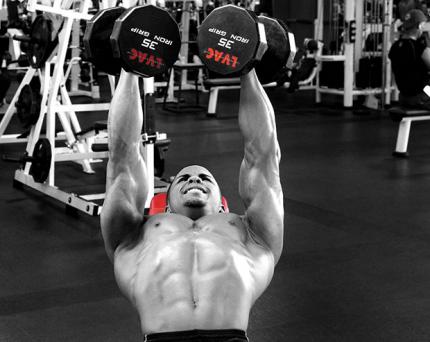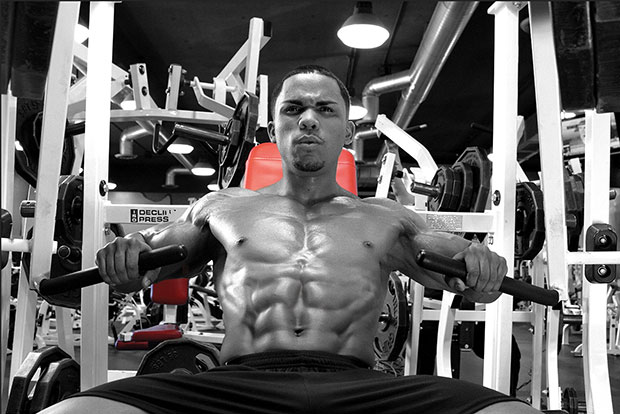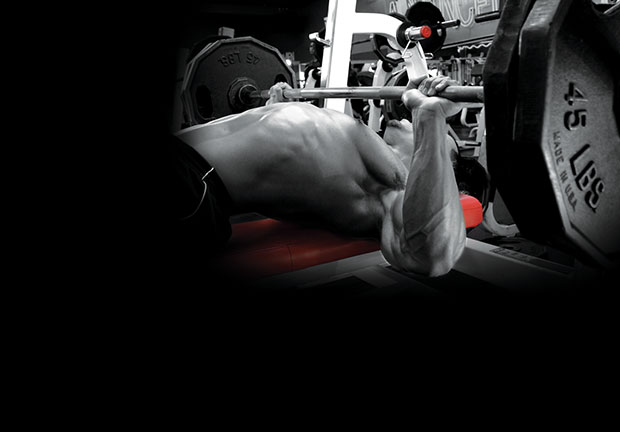The Romano Factor


Best in Chest - Chest training feature
Some say that shoulders are the mark of a man. While that may be true in silhouette, when you’re out at the beach, it’s your pecs that do the talking. That is, if you have any. If you don’t, or even if you do, training them is paramount. There’s not a dude reading this that doesn’t want a thick, round, chiseled chest. And if you do have one, you want to keep it and probably grow more of it. We all know it. Your chest is probably the first muscle you ever trained, along with biceps. It’s a muscle group that guys want first. Few newbies, if any, are talking about their forearms, and most, if not all of them, are talking about the chest they want. The guys lifting for ages still want to improve theirs. Anybody who knows where the gym is trains chest, usually on Mondays. Even the racketball guys.
The male pectoral region also plays a particular role in the human psyche. It’s something primal, inherent, part of our nature. It has to do, in part, with what attracts a female to a male. But, not in the way a nice, round ass attracts a male to a female. The two brains are wired differently; all you think about is bending that ass over. Women are different; they’re looking for a hunter. Several years ago, a study was conducted on female subjects that demonstrated distinct psychological reactions to various male images that focused on their pectoral muscles. Images of men with greater chest development instilled feelings of security in the women, not only in terms of protection but also in terms of trust and in providing for his family. The men with powerfully built chests made the women feel safe. The scrawny guys didn’t. Who do you think gets the girl?
From a bodybuilding perspective, a well-developed chest is the foundation of the upper body. Its central, elevated position on the body provides that everything else stems from it. And it does. One of the very first things we notice on a competitor is his chest. But, given its relative importance in both physique development as well as powerlifting, the chest is a relatively simple structure and not very difficult to train. In fact, the backbone of chest training, the bench press, is one of the three most powerful movements, next to deadlifts and squats.
Ryan Kennelly holds the WPO world record in the equipped bench press with 1,075 pounds! Arnold Schwarzenegger, owner of arguably one of the greatest chests of all time, only did two exercises for chest: bench press in varying angles and flies, either cable or dumbbell. That’s it. So, guess what exercise we’re going to talk about first?
Bench Press
Now, back in the day, we were pretty limited in what constituted the term “bench press.” It meant what it said: a flat bench with a straight bar loaded with plates. The variations were incline and decline, and you could swap out the bar for dumbbells. Today, while we still have great renditions of the old-school classic equipment, we also have a vast array of both selectorized and plate-loaded machines designed to hit the chest from every angle and position imaginable. Some are fluff, and some are what would logically be the result of modern technologically superior evolutions of the classic. However, the move that has stood the test of time and remains the number one chest exercise is the flat bench barbell press. When people ask you, “How much can you lift?” they’re referring to the bench.
How it’s done
Traditionally, the bench is performed with feet flat on the floor, pulled back toward the bench. This will allow you the option of “bridging” if you so desire. You can also perform stricter reps with your feet flat on the floor or up on the bench. Grip is a matter of preference; the wider your grip, the less the triceps assist in the lift. The closer you grip your hands, the greater the triceps assist. After a point, the wider your grip gets, the farther away you move from your strongest position. A good rule of thumb would be for you to position your hands so that your forearms are at 90 degrees to the floor. If you grip any wider than that, you’ll not only be weaker but also increase your chance of suffering an injury.
Your body should be positioned under the bar with your head far enough forward that when your arms are extended, the bar will be directly over your eyes and clear of the hooks. Some benches are designed with the hooks far enough in the way that you’re going to be in a risky position when you unrack heavier weights. In such a case, it’s nice to have a spotter give you a liftoff.
With your arms extended and the bar over your eyes, slowly lower the bar to your chest just below your nipples. Notice l didn’t say “release the bar in a free fall to crash into your sternum and bounce it up.” When the bar touches your chest, you can either bridge or initiate the press back up over your eyes in a slight arching motion until you lock out with the bar directly over your eyes.

Incline Bench Press
This move targets the “upper chest.” Some prefer this to the flat bench because of the emphasis it puts on the outer and upper aspects of the pec. Short Mr. Olympia Franco Columbu is known for his utterly insane upper pec development. As the story goes, the gym in Sardinia where he trained in the late ‘60s and early ‘70s had the back legs broken off its only bench. So, they used to lean the bench against the windowsill, effectively making an incline bench. Franco spent years doing only incline benches. Anyone having doubts about the results of this exercise need only Google pics of Franco. You’ll immediately take a hacksaw to the rear of your bench and clear off the windowsill.
The first question one would ask, when we deviate from a flat bench to an incline bench, is “How much of an incline?” If your bench is adjustable, you have a few options to find the level where you’re far enough back to hit the upper chest with the least amount of stress on the front delt. Some benches make that decision for you and can’t be adjusted.
How it’s done
Sit in the bench with your feet under you, pushing your back into the pad. Grip the bar as you did for flat bench and lift the bar off the hooks up directly over your eyes. Lower the bar with your forearms parallel to the rack stanchions until the bar touches the top of your pecs at the base of your neck. Initiate the upward movement by flexing your rib cage and pushing up with your elbows; your hands are only along for the ride. The idea is to focus more effort on your pecs and less on your triceps. You don’t necessarily have to lock out at the top of the movement; you can if you want to, but you’ll maintain more time under tension if you don’t lock out because of the length of the movement, which is rather long.

Decline Bench
While the traditional decline bench is perfectly adequate, I prefer the Hammer decline press because it’s a seated machine that keeps my head higher than the rest of my body instead of lower. I’m one of those people that gets really lightheaded when I get up from a position where my head is lower than my heart, especially while exerting myself. So, the Hammer decline press is ideal. I also think that with the seat adjusted correctly, it really hits the lower and inner chest better than anything else.
How it’s done
Adjust the seat a little higher than you think would be correct. The idea is to push down and out, not straight out. Your ideal grip will find your arms out in front of you with just a slight outward angle. This exercise starts from the down position, so you might want to have a training partner give you a lift out of the hole when the weights get heavy. Extend the weight in front of you and bring it down until just before it hits the stops. You can pause right there for a second, or explode out immediately. Press down and out until your arms lock out. Return to the down position and hit it again.

Incline Flies
Perhaps the best exercise to stretch the pec and work it throughout its entire range of motion with almost no help from the triceps, the incline fly is the perfect exercise to follow bench presses when your triceps are torched.
How it’s done
Grab a pair of dumbbells (leave your ego at the door when it comes to selecting the weight for this exercise. You don’t need much) and sit back in an incline bench with the dumbbells resting on your knees. Kick them up one at a time to your shoulders, and then press them up together and stop at the top with the dumbbells touching, directly over your eyes. Lower the weight slowly by pivoting your upper arm in the shoulder joint and opening your arms as they descend, bending your elbows slightly as you go down. Descend until your pecs stretch to a stop. Press with your elbows and bring the dumbbells back to the up position directly over your eyes again. Repeat.

Weighted Dips
This is a great finishing exercise that works not only the pecs but also the front delts, triceps, and anterior serratus. It’s an exercise that the pros say “ties everything together.” When you add weight to a standard dip, you really take it to a whole other level. If you want to increase your bench, you’d do well to add weighted dips to your routine.
How it’s done
You’ll need a belt designed to hang a dumbbell or a plate or two between your knees. Choose your weight, strap it on, and then step up into a dip rack. Hop up into the up/start position with your elbows locked out. Slowly lower your body until your upper arm is parallel with the floor. Push yourself back up until your elbows lock out. Repeat. You can also do negatives really easily by using the step to get yourself into the up/start position. Then slowly lower yourself. Then use the step to get back up to the top. Slowly lower yourself again. Keep going until you can’t resist any longer. You can also use anchor chains around your neck instead of the weight belt. Just remember, the weight around your neck causes your shoulders to act as a fulcrum to a lever that wants to pull your head down and your feet back and up. You’ll have to fight against having your ass end up over your head!

The Workout:
The first move is going to be the power move:
Flat Bench – 4 sets of 10 reps to work up to a working weight for
5 sets of 5 reps as heavy as you can, with a spot on the last one or two reps. Then move on to:
Incline Bench – 6 × 8 – 12 reps
Decline Bench – 6 × 8 – 12 reps
Incline Flies – 4 × 15 – 20 reps
Weighted Dips – 4 × 10

Top 10 Chests of All Time
(according to Romano)
1 – Arnold Schwarzenegger
2 – Franco Columbu
3 – Lou Ferrigno
4 – Ronnie Coleman
5 – Dennis James
6 – Joel Stubbs
7 – Kai Greene
8 – Jay Cutler
9 – Art Atwood
10 – Marcus Rühl
For more articles on how to build a monster chest, click here!

